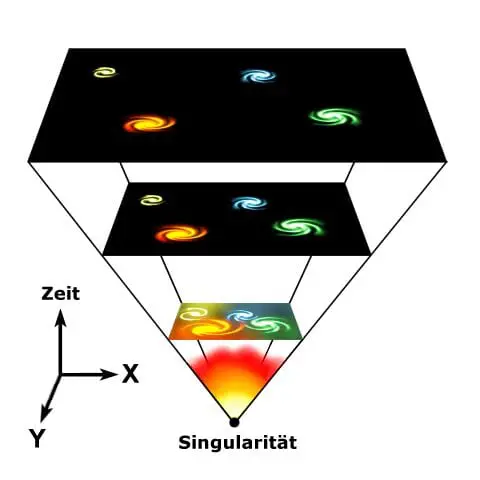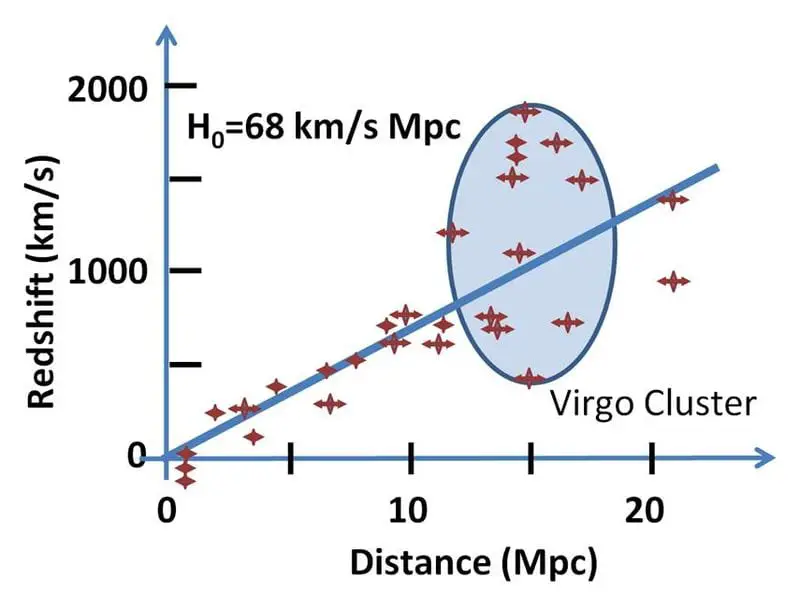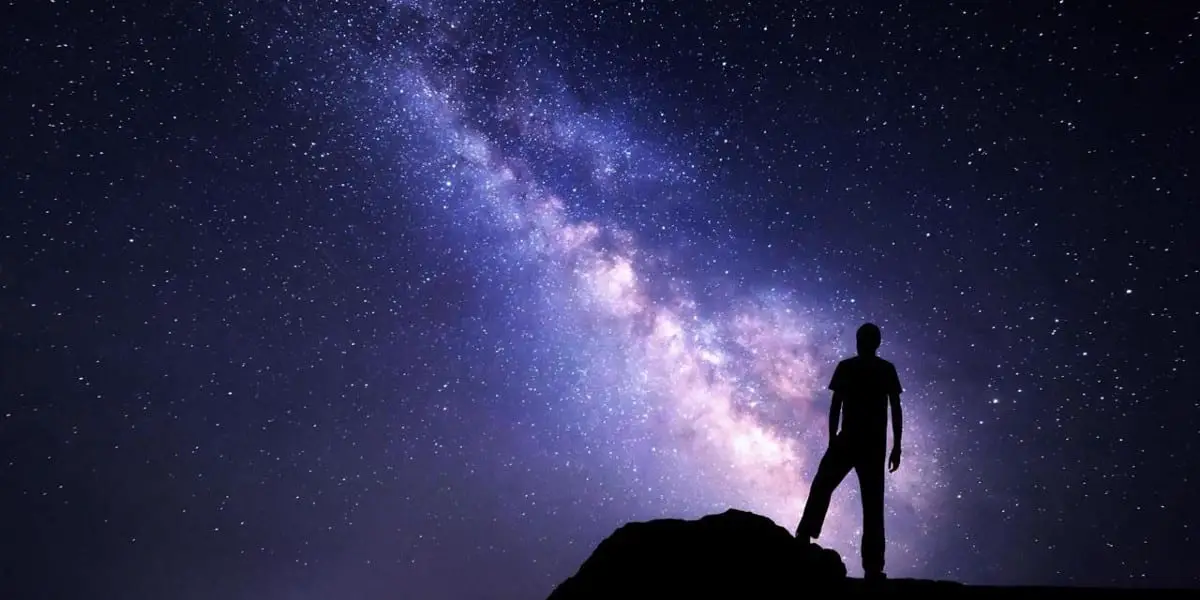First of all, you should know that Hubble’s Law Of Cosmic Expansion is the most celebrated Paper in the history of physical science. Yup, even more than the physics of black holes.
In fact, if Hubble’s expanding universe theory has not been discovered then we might have been still living in the dilemma that whether our universe is static or expanding or even our universe is shrinking.
What Is Hubble’s Law Of Cosmic Expansion?

Hubble’s expansion law states that “Objects Observed In Extra-Galactic Space (Deep Space) Are Shifting Away Or Receding Away From Earth.
In other words, According to Hubble’s law of cosmic expansion, all the galaxies are moving away from our own. A phenomenon in today’s world is known as Cosmic Recession.
Not to mention, Hubble’s law solidified the physics of the expanding universe. Meaning, we are living in the ever-expanding universe.
This expanding universe theory is also known as Cosmological Red-Shift; only and only if the galaxy is receding away from planet earth.
In fact, you can also say that the cosmological redshift was the phenomenon observed by Edwin Hubble which was used to explain the expansion of the universe
On the other hand, if the galaxy is approaching the earth, it’s called Cosmological Blue-Shift. Take a note here. Cosmological redshift is used to measure the physics of the expanding universe. Therefore, it is not truly a Doppler effect.
Historical Facts About Hubble’s Law
If you don’t know, it was Albert Einstein’s General Theory Of Relativity’s Papers from which the notion of the ever-expanding universe arrived.
As a matter of fact, almost a decade before Edwin Hubble’s declaration of Hubble’s Expansion Equations; in 1922, a Soviet Russian Mathematician and Physicist Alexander Friedmann had derived Friedmann’s Equations from Einstein’s Field Equation.
Alexander Friedmann showed that the universe might be expanding, directly contradicting the Classical View of the Universe that we are living in a Static Universe or Newtonian Universe.
Moreover, five years after Alexander Friedmann’s Friedmann’s Equations and two years before Edwin Hubble’s Hubble’s Law; a Belgian Astronomer Georges Lemaître proposed The Expanding Universe Theory.
In fact, he also proposed a hypothesis of the Primeval Atom or the Cosmic Egg. A hypothesis, which in today’s world is famously known as the big bang theory of the universe.
Mathematical Representation Of Hubble’s Expansion Equation

The mathematical representation of Hubble’s Law Of Cosmic Expansion is stated as:
V = H × d
where
V = Galaxy’s recessional velocity
H = Hubble Constant or Hubble Parameter
d = Galaxy’s distance from the one which it’s being compared
Hubble Constant is constant only in space but changes over time; therefore, the currently accepted value is 70 kilometers/second per megaparsec
Hubble’s Law And Einstein’s Blunder
While developing his General Theory Of Relativity; Einstein assumed the universe to be static and dynamically stable. Meaning, the universe is neither expanding nor contracting.
In fact, he was actually using the same assumption Sir Issac Newton did for his newton’s law of universal gravitation. An assumption that we know as a Static Universe (Steady-State Theory).
But, when the experimental observations of General Relativity were compared with the theoretical prediction; both the results (experimental and theoretical) were different.
In other words, Einstein theoretically assumed the universe to be a static one. On the contrary, the experimental observation showed that the universe is rather expanding or it will contract (observations like bending of light by large masses or the precession of the orbit of mercury).
Therefore, in order to counteract the observational results, Albert Einstein had to modify his General Theory Of Relativity by introducing the Cosmological Constant.
A constant that is used to produce a static solution to counter the effect of gravity, simply to produce a perfectly Static and Flat Universe.
However, after the discovery of Hubble’s Law Of Cosmic Expansion, Einstein had to abandon his work on Cosmological Constant.
Albert Einstein himself called his assumption of the Cosmological Constant; the biggest blunder.
Conclusion
Well, what do you think? Was the hypothesis of cosmological really the biggest blunder? Or, maybe we just don’t know how to effectively utilize it….!!! I mean, there was a time when people believed in the Aristotelian universe.
But, in today’s world, it comes in the list of one of the obsolete cosmological models of the universe. What I want to say is there is always a possibility for new laws in the world of physical science. What do you think? Is Hubble’s law of cosmic expansion is really untouchable?
That’s it for this post. If you like this article, share it if you like it, like it if you share it. You can also find us on Mix, Twitter, Pinterest, and Facebook.

I’ve never actually heard of this before! But you learn something new every day and this was my new thing learned for today.
This is all so interesting! I was actually really into Physics in high school and was the VP of our Physics club, I wish I kept up on it more as an adult.
Now I can see why my head wasn;t egg-shaped and full of existential information that I would barely ever use.
This is such an interesting article to read. Very informative and detailed about hubbles law of cosmic expansion. I really love to learn more in Physics and I have learn a lot now.
The universe is a continuous mystery which often leaves us wandering about the possibilities. May I ask what`s your website niche?
❀ Grace ❀
I’m sorry to disappoint the author, and please the astronomers, but the Hubble Constant is a truly fixed constant, as demonstrated by the following equation:- 2 X a mega parsec X C, divided by Pi to the power of 21 = 70.98047. For this equation, a parsec is the standard 3.26 light years. This equation comes from ‘The Principle of Astrogeometry (Kindle Books). As the Hubble Constant is ‘fixed’ in value, its reciprocal of 13.778 billion light years is also ‘fixed’, and so cannot be the age of the universe, but is the Hubble horizon distance ONLY. This proves the random ‘big bang’ is a fake hypothesis, based on the erroneous Friedmann hypothesis. It’s certain you will not understand this equation, but if you do, a proper scientific counter argument will be welcome. A Professor at Imperial College in Kensington, London described this Hubble equation as ‘elegant’, David Hine.
All the contents you mentioned in post is too good and can be very useful. I will keep it in mind, thanks for sharing the information keep updating, looking forward for more posts.Thanks marriage certificate attestation in Nigeria
thankyou for sharing you experience.
well, i would say you never say no. you can continue now.
well, i will say if you cant use then may be your children can. i mean if they are into physics or something.
thankyou so much for your valuable feed back.
ahmm !! in my view its physics. i mean i try to cover whole but its not possible though.
well, brother i got your view point. may be i wont understand the mathematics you wrote, but i definately understood the physics behind it. on the other hand, i am partially agreeing with you. i mean i wont say that big bang is fake. i would say that there are so many big bangs that had happened before. and on the other hand, there will be so many big bangs that will happen in the future too. just because we cant see something that dosent mean it does not exist.
thankyou so much for you precious reply. hope you will see more from my blog.